Astronomy - Supermoon and Geminids Duke it Out
In a spectacular case of bad timing, the full Moon coincides with the annual Geminid meteor shower. Don't feel put out. There's still something for everyone, including a consolation prize.

Although they can appear anywhere in the night sky, Geminid meteors appear to radiate from the constellation Gemini, which is well above the horizon by late evening.
Sky & Telescope
Sky & Telescope
A supermoon is a good thing. So is a rich meteor shower. But the two together? Maybe not so good. But that's exactly what will happen on the night of December 13–14 when the Moon reaches full phase at 7:06 p.m. Eastern time just hours before the peak of the annual Geminid meteor shower.
The brilliant Cold Moon, the third of this year's three supermoons, will flood the sky with light all night long and slash the number of Geminids visible from around 120 per hour to more like a dozen per hour. Shower members, which can appear anywhere in the sky, all trace their paths back to a radiant point near the star Castor in Gemini, the constellation that lends its name to the famous downpour.
Is a dozen an hour worth it? You bet. The Geminids are one of the most consistent and richest showers of the year. Fireballs are common. It's also one of the few showers that's active during mid-evening because the radiant is already well up in the eastern sky by 10–10:30 p.m. local time. If you don't want to set the alarm for a chilly 2–4:00 a.m. session, when Gemini reaches its greatest altitude in the southern sky, you can get a passably good look at the shower before bedtime.
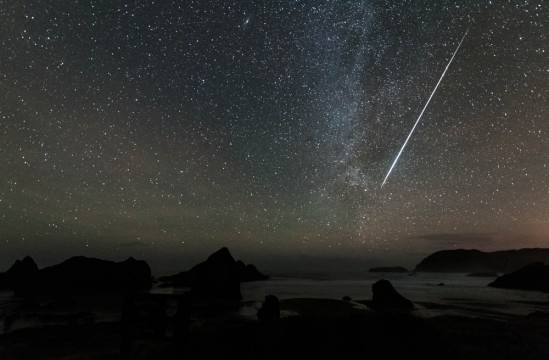
A Geminid fireball blazes over Meyers Creek Beach along the south Oregon coast on December 14, 2015. We can only be patient — next year, the shower peaks with the Moon a waning crescent.
Ranbo55
Ranbo55
Invite a friend over or take your kids out for a look. Just make sure everyone's dressed warmly and preferably stretched out on lounge chairs under sleeping bags or warm blankets. Or fire up the hot tub, a favorite hangout for shower watching. Face east or north before midnight and try to avoid looking at the Moon to preserve whatever night vision you can muster.
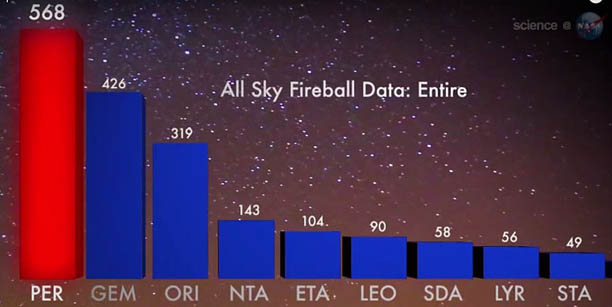
The Perseids (PER) and Geminids (GEM) are tops when it comes to producing fireballs, giving observers hope for a reasonably good shower despite moonlight this year. The data was gathered using NASA's network of all-sky cameras. Fireballs numbers are shown from 2008 through mid-2013. The average peak magnitude for a Perseid fireball was –2.7; for the Geminids, –2.
NASA
NASA
After midnight and before dawn, face south or west. Geminids are one of the few showers that don't originate from dust strewn by a comet. Instead, the stream's parent body is the asteroid 3200 Phaethon (FAY-eh-thon). Sometimes referred to as a "rock comet," Phaethon is a rare asteroidal object that primarily ejects fragments of rock instead of water vapor, gases and dust when heated by the Sun the way comets do.
Trails of dust have occasionally been observed departing Phaethon, seeding its orbit with future Geminids. Each year in mid-December, the Earth passes through the debris, which smacks into the atmosphere at 80,000 miles per hour (129,000 km/hr). Each entering particle's great speed briefly sets the air aglow to create a titillating meteor flash. Because asteroidal material can penetrate the atmosphere more deeply than comet dust, Geminids produce longer streaks than some showers.
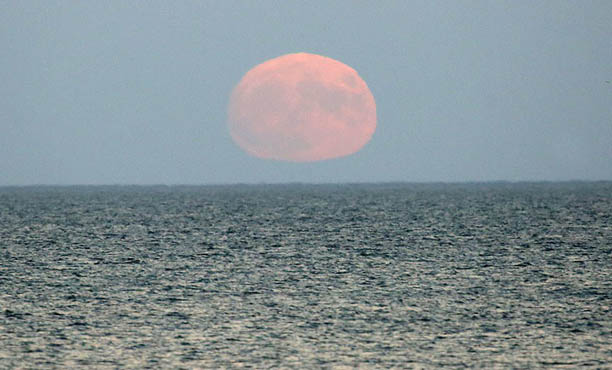
Last month's supermoon, the closest until 2034, captured moments after rising over Lake Superior on November 13, 2016. Refraction causes its flattened shape. December's supermoon will be about 1,950 miles farther from Earth than November's.
Bob King
Bob King
Of course it will be hard to ignore the Moon that night. And you shouldn't. If we define a supermoon as a full Moon that occurs within 90% of its closest distance to Earth, December's Moon makes the cut, even if it's the most distant of the year's supermoon trio. Second place goes to the October Hunter's Moon and first to the Beaver Moon on November 14, the closest supermoon since 1948.
The December Moon will glare from eastern Taurus near the Gemini border and climb even higher in the sky than last month's, beaming down with enough intensity to render some aspects of the landscape in color, such as signage, trees, and even bright clothing.
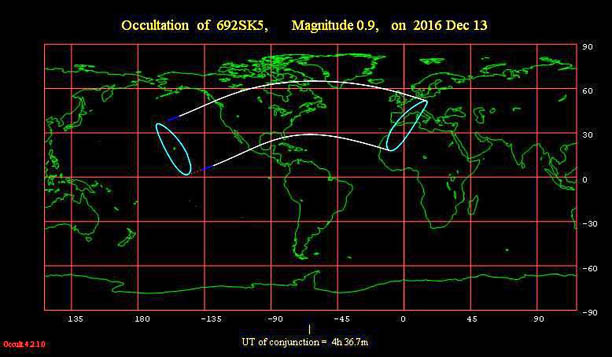
Observers located within the broad swath defined in white will see the Moon occult Aldebaran on the night of December 12–13. Click the map for a complete list of disappearance and reappearance times for many cities.
Occult 4.2
Occult 4.2
If you're still feeling a sense of disappointment at seeing the Geminids pared back, there's a consolation prize. The night before the great clash, the waxing Moon will hit the bullseye — literally — when it occults the star Aldebaran in Taurus. On the evening of December 12th across the Americas (early morning of the 13th for Western Europe), you can use binoculars or a telescope to watch the Moon cover and then uncover the bright star.
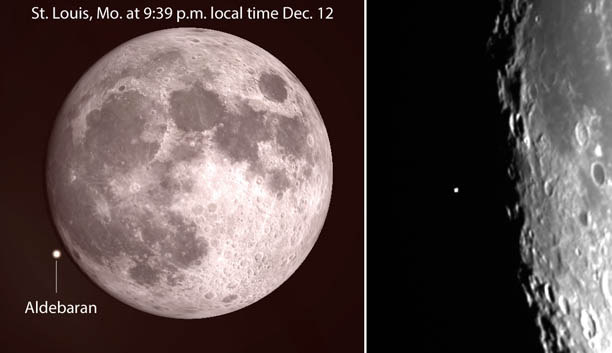
Left: A simulation of Aldebaran and the Moon 2 minutes before immersion as viewed from St. Louis on December 12th. Right: On December 23, 2015, a similar waxing gibbous Moon approached and occulted Aldebaran.
Stellarium (left) / Gianluca Masi
Stellarium (left) / Gianluca Masi
An example is shown above; click here for times for more than 1,100 U.S., Canadian, and European cities. Because the listed times are in UT, remember to subtract 4 hours to convert to Eastern Standard, 5 for Central, 6 for Mountain, and 7 for Pacific.
My location has been under clouds for so many nights, I can't wait to see any or all of these wonderful events. Moonlight, meteors, and a disappearing star — sounds positively festive!
No comments:
Post a Comment